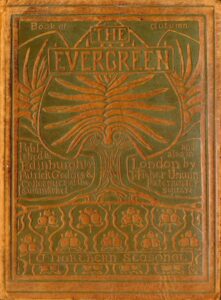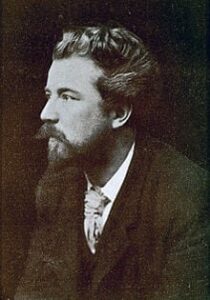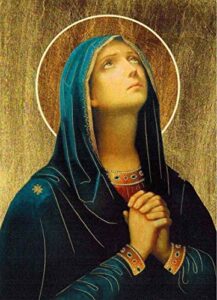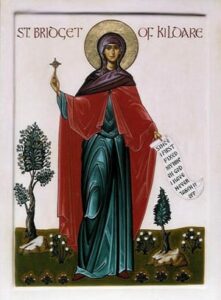The Evergreen: A Northern Seasonal – Power, Women and Religion’s Influence in Mary of the Gael
©Melissa Emanoilidis, Ryerson University, 2018.
Introduction

When looking back at the creativity displayed in the nineties writings of “little magazines”, one is able to research deeper and more analytical discoveries to each specific piece of work published. Specifically in the magazine, The Evergreen: A Northern Seasonal (Figure 1), the writing “Mary of the Gael” by Fiona Macleod has a strong representation of women, folklore, and power in order to help understand the Celtic Revival. The story firmly grasps the relation between religion and the mistreatment of women during the nineteenth century. Through symbolism and implicit meanings, Mary of the Gael strongly interpret the Catholic beliefs relationship to Celtic folklore while still being able to identify this idealization that was created around a woman’s purity, or in other words, virginity. In Mary of the Gael, the power of the patriarchy and the church is introduced, continually shown through the Bride’s relationship with her father and the strong connection between herself and the Virgin Mary.
Fiona MacLeod

William Sharp, who concealed his name under the name of Fiona Macleod, was born September 12, 1855 in Paisley, United Kingdom and died December 12, 1905 in Castello de Manlace, Italy (Figure 2). He ended up marrying his first cousin, Elizabeth Amelia Sharp. He was a Scottish poet, novelist, short story writer, biographer, essayist, and dramatist. He was known for his most early work, specifically Sospiri di Roma, which was a poetry collection in which he “first employed a feminine persona” (Contemporary Authors Online). He created this alternate name, which created suspicion for avid readers who picked up on how similar Fiona MacLeod’s writing was to Sharps. His work was commonly “filled with fantasy, lyrical descriptions of landscape” and filled with “spitituality”, while MacLeod’s contained more of a “Celtic Renaissance” (Contemporary Authors Online). Examinations of Sharp’s found the use of “feminine pseudonym” do be quite controversial. But, despite this, the creation of two different personas, both displaying humor and having a “very rich sweet nature” allowed readers of either MacLeod or Sharp to be welcoming to male and female (Contemporary Authors Online). Both were published in the Evergreen for their works.
“Mary of the Gael”

The story “Mary of the Gael” by Fiona MacLeod develops on the legend of St. Brigid, or in other words “the bride” or Ireland. It tells the story of how St. Brigid was born out of wedlock, which is considered to be incredibly shameful during that time period. With this, the Bride grew up following her love for God, later becoming a slave to her father. Despite all this solitude, she was at peace with it, and travelled far and wide in order to spread her wisdom and generosity with others. The story emphasizes her innocence, referencing the colour white in relation to her clothing as well as her surroundings. The Bride is also claimed to have been blessed by God, which is displayed through the mentioning of the Holy Spirit; “…dusky red and wan yellow tongues moved to and fro. The sacrifice of God was made” (MacLeod, 131). Following this, the Bride felt the need to travel once more, which leads her into an encounter with the Virgin Mary (Figure 3). This can be taken as a reference to her meeting someone so similar to her mother, known to be poor and a slave. With this, the Bride provides the Mother Mary with comfort and support through her post given child birth, ironically helping a virgin mother despite she was born out of wedlock. Although the Bride does not have a child, she bears these motherly characteristics, bearing gifts of kindness and love to all those she comes across. She was considered to be “the Virgin Sister of the Virgin Mother” as well as “the Foster-Mother of Jesus that is the Christ” (MacLeod, 143). MacLeod ends the story with the Bride understanding that she had just assisted in a miracle, and continued to help those until the day that she died.
Power of Women
One large aspect on the Mary of the Gael was the emphasis around the innocence and virginity of the Bride. There are several references to the colour white throughout the story, trying to display her youth. The text states: “As she moved onward through the gloaming she described white walls beyond her: white walls and square white buildings…” (MacLeod, 133). There are also many references of her wearing white, which do indicate that she was a Bride, but one that still held her virginity. The constant comparison to the Virgin Mary, and how she will protect her from the flames of Satan seems very visual and off-putting. There are several more subtle comparisons between the two that was found. Although it is still emphasized upon in a religious sense, socially it is not as pushed that one must be a virgin upon marriage. There is the reference that St. Bridget (Figure 4) is innocent, stating that she will not be put in hell because the Virgin Mary has protected her. It can be argued that the roles were not equal between the two genders, as well as they did not have the same rights. Although religiously the Lord spiritually bonds them, the woman continues to be the caretaker for the man. This also strings off of the idea that women are supposed to be innocent, similar to the way the Bride is portrayed in Mary of the Gael. In this story, which differs from other religious tales, is that there is a woman figure as the lead. She seems to be somewhat similar to Jesus Christ, which is shown by spreading the message of God to others. This can go into more of a deeper meaning through the Bride taking physical care of the Virgin Mary’s child, almost as though she was meant to run into them in order to pass on her gifts to the newborn child.

Relationship Between Virginity and the Church
Although it seems her relationship with her father in the story is nothing but sweet, he emphasizes the purity that the Bride must hold. “A tall figure moved towards her, clad in white…” (MacLeod, 134), is later recognized as her father. It is clearly written by MacLeod that she follows every word that her father asks of her, responding simply with “Yes, my father?” (MacLeod, 134) repeatedly. He does force her to go to Bethlehem, where she is introduced to Mother Mary, the symbolism around white is emphasized even more strongly. There are white doves, white robes, and white flowers, all in which MacLeod placed strategically within the writing for the reader to understand that there was a specific expectation of women during that time period. This also displays the hierarchy of the church by having all the religious figures, including her father, be dressed in all white. This is demonstrating that they are pushing for this innocence and purity. St. Brigid did not care for beauty, asking for all of it to be taken from her so that she could be alone and focus solely on religion and be able to serve the Lord. With this, MacLeod continues to drive away from the norms that are often emphasized upon in religion; women are known to wait until marriage to have sex and then be the caretakers for their children and husband. The Bride does the opposite, although still not engaging in sex, she stirs away from the need for the act all together, truly focusing on the power of religion in a more symbolic way. She continued to help those who were had children out of wedlock, due to the way she was treated by her father. Her father was displayed of higher power, treating her as a slave the same way her mother was. The Bride broke the boundaries of the church by not serving the purpose to be married and have children, yet still was rewarded by God in the end.
The Meaning Behind The Bride
The writing, “Mary of the Gael”, provides the readers with revived Celtic folklore. MacLeod romanticizes it throughout the text, aiming for a more female audience, although this technique was commonly used, as a way for the common english romantic to “accept the invitation offered to them” (Carruthers, 11). The meaning of the story runs much deeper than a gracious and generous woman who simply stumbles upon the Virgin Mary, but proves that a woman does not need to follow every boundary of the church and still be blessed with the gifts of God. Being someone who seemed almost doomed from the start, being birthed from something claimed to be so sinful in the church, it is ironic that the Bride was idolized so much. She proves to break the borders of what is expected of women, to simply just be a stepping stone for a man, and wishes nothing more than to live her life simply serving the Lord. MacLeod, with her feminine writing style, portrays the Bride in a very womanly, yet strong, manner. She is claimed to be one “who grew in beauty and grace, so that all men marvelled” (MacLeod, 128), but she wished otherwise. She walked far passing wild beasts while being barefoot, all in the hopes of helping others. Despite the controversy of her parents, and the mistreatment from her father, St. Brigid proves to be a powerful woman, one who surpassed the power of the church. Her Father, one who was portrayed as a religious figure, as previously mentioned was wearing all white, was still respected by his daughter, but she did indeed have the strength to leave him by the age of eighteen. She had physical and mental strength, as “all night she walked; now upon the high slopes of a hill” (MacLeod, 146). It was claimed that “it was accounted a superlatively virtuous action to desert your wife and children and take to Jesus” (Ross, 39). St. Brigid did more than this. She simply refused to have the option to abandon anyone, beginning her life with the purpose of serving to God, and along the way passing her gifts onto the next, Jesus Christ, who continued with this message.
Conclusion
“Mary of the Gael” by Fiona MacLeod is a very inspiring religious piece. It not only reflects on the romantic side of these legends, including the beauty of the Bride and the sacredness of virginity, but demonstrates a women finally in a dominant role. Through most religious Catholic stories, including those in the Bible, there is a common theme of there being a man as the highlighted figure. St. Brigid is portrayed by MacLeod as a powerful and independent woman, one who does not play into the role of forever being a slave to her father and dedicates her life goal to spreading the everlasting word of God. MacLeod uses this story to prove that beauty is only the surface, and that inner beauty shown through outstanding actions is just, if not more, recognizable to others. Despite the future that her parents had set up for her, already breaking the rules of the church by having her out of wedlock, St. Brigid uses this to her advantage, proving otherwise to people that she was more than a pretty face, inevitably leading her to the meeting of, the one and only, Jesus Christ.
Works Cited
English Romanticism and the Celtic World, edited by Gerard Carruthers, and Alan Rawes, Cambridge University Press, 2003. ProQuest Ebook Central, https://ebookcentral-proquest-com.ezproxy.lib.ryerson.ca.
Ross, William Stewart. Women: her glory, her shame, and her God: by Saladin. W. Stewart & Co., [188-?]. Nineteenth Century Collections Online, http://tinyurl.galegroup.com.ezproxy.lib.ryerson.ca. Accessed 10 Nov. 2018.
“William Sharp.” Contemporary Authors Online, Gale, 2003. Literature Resource Center, http://link.galegroup.com.ezproxy.lib.ryerson.ca. Accessed 17 Oct. 2018.
Images in this online exhibit are either in the public domain or being used under fair dealing for the purpose of research and are provided solely for the purposes of research, private study, or education.
